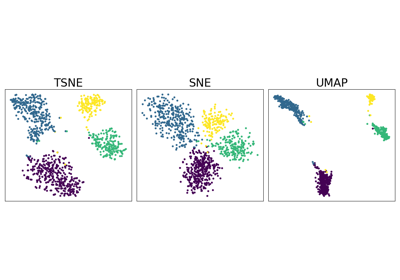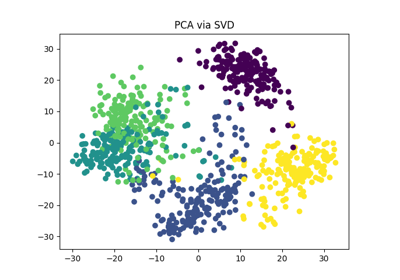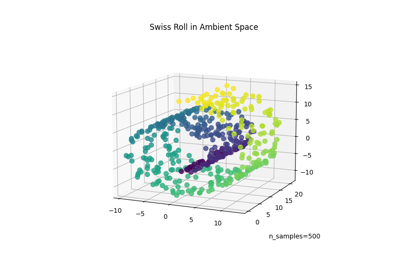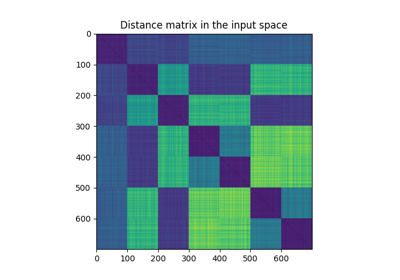AffinityMatcher#
- class torchdr.AffinityMatcher(affinity_in: Affinity, affinity_out: Affinity | None = None, kwargs_affinity_out: Dict | None = None, n_components: int = 2, loss_fn: str = 'square_loss', kwargs_loss: Dict | None = None, optimizer: str | Type[Optimizer] = 'Adam', optimizer_kwargs: Dict | None = None, lr: float = 1.0, scheduler: str | Type[LRScheduler] | None = None, scheduler_kwargs: Dict | None = None, min_grad_norm: float = 1e-07, max_iter: int = 1000, init: str | Tensor | ndarray = 'pca', init_scaling: float = 0.0001, device: str = 'auto', backend: str | FaissConfig | None = None, verbose: bool = False, random_state: float | None = None, check_interval: int = 50, compile: bool = False, **kwargs)[source]#
Bases:
DRModulePerform dimensionality reduction by matching two affinity matrices.
It amounts to solving a problem of the form:
\[\min_{\mathbf{Z}} \: \mathcal{L}( \mathbf{P}, \mathbf{Q})\]where \(\mathcal{L}\) is a loss function, \(\mathbf{P}\) is the input affinity matrix and \(\mathbf{Q}\) is the affinity matrix of the embedding.
The embedding optimization is performed using a first-order optimization method, with gradients calculated via PyTorch’s automatic differentiation.
- Parameters:
affinity_in (Affinity) – The affinity object for the input space.
affinity_out (Affinity, optional) – The affinity object for the output embedding space. Default is None. When None, a custom _loss method must be implemented.
kwargs_affinity_out (dict, optional) – Additional keyword arguments for the affinity_out method.
n_components (int, optional) – Number of dimensions for the embedding. Default is 2.
loss_fn (str, optional) – Loss function to use for the optimization. Default is “square_loss”.
kwargs_loss (dict, optional) – Additional keyword arguments for the loss function.
optimizer (str or torch.optim.Optimizer, optional) – Name of an optimizer from torch.optim or an optimizer class. Default is “Adam”.
optimizer_kwargs (dict, optional) – Additional keyword arguments for the optimizer.
lr (float or 'auto', optional) – Learning rate for the optimizer. Default is 1e0.
scheduler (str or torch.optim.lr_scheduler.LRScheduler, optional) – Name of a scheduler from torch.optim.lr_scheduler or a scheduler class. Default is None (no scheduler).
scheduler_kwargs (dict, optional) – Additional keyword arguments for the scheduler.
min_grad_norm (float, optional) – Tolerance for stopping criterion. Default is 1e-7.
max_iter (int, optional) – Maximum number of iterations. Default is 1000.
init (str, torch.Tensor, or np.ndarray, optional) – Initialization method for the embedding. Default is “pca”.
init_scaling (float, optional) – Scaling factor for the initial embedding. Default is 1e-4.
device (str, optional) – Device to use for computations. Default is “auto”.
backend ({"keops", "faiss", None} or FaissConfig, optional) – Which backend to use for handling sparsity and memory efficiency. Can be: - “keops”: Use KeOps for memory-efficient symbolic computations - “faiss”: Use FAISS for fast k-NN computations with default settings - None: Use standard PyTorch operations - FaissConfig object: Use FAISS with custom configuration Default is None.
verbose (bool, optional) – Verbosity of the optimization process. Default is False.
random_state (float, optional) – Random seed for reproducibility. Default is None.
check_interval (int, optional) – Number of iterations between two checks for convergence. Default is 50.
compile (bool, default=False) – Whether to use torch.compile for faster computation.
Examples using AffinityMatcher:#

Neighbor Embedding on genomics & equivalent affinity matcher formulation



